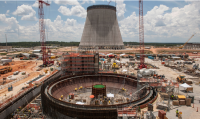Strong Industry Response to EPA Clean Power Plan
by Jim Hopf
 There has been a strong response from ANS, the Nuclear Energy Institute (NEI). and many other organizations, pointing out the flawed treatment of nuclear in the EPA's proposed Clean Power Plan (CPP). And it appears that these efforts may be having an impact. The EPA has recently stated that the nuclear provisions of the CPP "have raised concerns among stakeholders" and "would likely be revised."
There has been a strong response from ANS, the Nuclear Energy Institute (NEI). and many other organizations, pointing out the flawed treatment of nuclear in the EPA's proposed Clean Power Plan (CPP). And it appears that these efforts may be having an impact. The EPA has recently stated that the nuclear provisions of the CPP "have raised concerns among stakeholders" and "would likely be revised."
Treatment of existing plants
A strong chorus of voices from many organizations has pointed out obvious problems with how existing nuclear generation is treated by the plan. Specifically, the issue is that only 5.8 percent of existing nuclear generation counts toward the state-by-state goals of reducing the tons of CO2 emitted per MW-hr of electricity generation. With respect to the state CO2/MW-hr goals, the EPA (in a bizarre fashion) defined MW-hrs as something other than the total MW-hrs generated in the state. Instead, the MW-hr total was defined as the sum of all MW-hrs produced by fossil and renewable sources, plus only 5.8 percent of the MW-hrs generated by nuclear. (Some existing hydro sources also had their generation similarly discounted.)
Many responding organizations pointed out that treating non-emitting sources differently, under a plan whose stated objective is reducing CO2 emissions, is indefensible. In fact, in its formal response to the EPA's CPP, NEI used the (legal) terms "capricious and arbitrary" to characterize the CPP's treatment of nuclear (as did I, in a comment in another ANS Nuclear Cafe article). Perhaps the language was meant to be a subtle message that the industry may consider legal action if the CPP is not changed, to treat all non-emitting sources equally. That message should be sent, and I believe that the industry would likely have a good case.
NEI, ANS, and others also argued that, with the (tiny) 5.8-percent factor applied, the CPP would probably not give any significant boost to nuclear, or achieve its stated goal of keeping existing nuclear plants open. In fact, in many states, the CPP may actually create a tangible incentive to close existing nuclear plants and replace them with gas-fired generation, as discussed in this very informative ANS Nuclear Cafe article.
NEI suggested other ways to incentivize existing nuclear generation, such as having nuclear generation in excess of some capacity factor goal "count toward" the EPA's CO2 reduction goal. I don't think NEI means that the CPP should still maintain some bizarre definition of CO2/MW-hr, where only certain MW-hrs "count" toward the total. I think it mean that the EPA should consider those MW-hrs when deciding what CO2/MW-hr goal would be appropriate for each state.
Treatment of new plants under construction
NEI, as well as some states and utilities, have also complained about the treatment of new reactor projects under the CPP. As I discussed in a previous article, the EPA considered the plan that each state already had in the works when deciding the emissions reduction goals for each state. Thus, the goals were based on the assumption that those plans would continue to go forward. In the case of Georgia and South Carolina, those plans included a major effort to built two new nuclear power plants (each with two reactors). The decisions to build those plants were made before the EPA developed the CPP.
NEI, and states like Georgia, have taken issue with this approach, arguing that the CPP is essentially penalizing those decisions, by saddling states that made such (good) decisions with a lower CO2 emissions goal. NEI said that by effectively penalizing those decisions, the EPA is actually creating a disincentive for states, and utilities, to invest in nuclear projects. NEI and the states also argued that the stricter emissions goals would be hard for the states to meet, particularly if any of the plans (such as the reactor construction projects) do not go forward for some reason.
My perspective-Existing plants
NEI, ANS, and other groups have it exactly right with respect to the treatment of existing nuclear plants under the CPP, and it's encouraging to hear that the EPA is likely to revise the plan in response to the commendable effort the industry and nuclear professionals have made to have their voices be heard. It is obvious that all non-emitting sources should be treated equally under a plan whose stated goal is to (and only to) reduce CO2 emissions. Any differing treatment should be challenged in court, if necessary.
With respect to the lack of actual incentive (and perhaps disincentive) to keep existing plants open, some have even questioned if this was unintentional. I'm not sure I can dismiss this myself. If it were true that it was intentional, it would be politically brilliant. You put forward a plan that is advertised as a way to help keep nuclear plants open, but actually (secretly) has the opposite effect. Then you get to say, "These nuclear plants were so uneconomical that even with the help we provided, they closed anyway." Whether this is true or not, the needed response is clear. The industry needed to make its objections (to the arbitrary 5.8-percent factor) loudly heard, and work to get it changed.
What the appropriate reduction goal is for each state is arguable, but one thing is absolutely clear. The definition of emissions intensity needs to be the total state utility sector CO2 emissions divided by the state's total generation (in MW-hrs) from all sources, period, end of story. There is absolutely no defensible basis for having it be defined any other way. After all, this is about reducing CO2 emissions. That reform simply must be made.
Once the above reform is made, the only issue left is (or should be) what the appropriate reduction goal is for each state. People need to understand that. They also need to not make things more complicated than they need to be.
Given that emissions intensity is correctly defined, the only tangible aspect of the CPP is (or should be) the emissions intensity reduction goals for each state, and the basis the EPA used to set them. Once the EPA goal is set, all sources of emissions reduction effectively get "equal credit." All forms of nuclear generation, above or below any given capacity factor, whether from keeping old plants open, building new ones, or through capacity uprates, are automatically given the same degree of credit, or incentive.
At that point, in terms of what would "best" incentivize nuclear generation, the answer is simple. The lower the state's emissions intensity target, the more the incentive. This segues into my perspective on the treatment of new plants under the CPP.

My perspective-Plants under construction
NEI and states such as Georgia have made the argument that setting emissions goals that assume nuclear construction projects will be completed is unfair to states with such construction projects and, given the lack of reward for deciding to build the reactors, will actually end up creating a disincentive for new nuclear in the long run. Many other commentators are lining up with that position as well.
I have to say, in my view, that a simpler logic applies. The more stringent a state's emissions intensity goal is, the more incentive they have to increase the use of nuclear. (Again, given that emissions intensity is correctly defined; where all nuclear MW-hrs apply fully.) In the case of Georgia, a stringent goal would probably remove any likelihood of the Vogtle-3 and -4 not being completed. Also, the lower the emissions intensity target, the greater the likelihood is of Georgia (and Southern Co.) building even more nuclear plants (as is being discussed by the company).
In both NEI's formal response, and in the testimony of a Georgia Public Service Commission official, references appear to be made to the notion or possibility of the Vogtle-3 and -4 projects not being finished. I personally find it very disquieting to hear such a notion being raised by high ranking officials and (even) nuclear industry organizations. (It's possible that they were referring only to delays in the projects, and the impacts of such delays on shorter term emissions goals.) If they are referring to a decision to cancel the projects and go back to fossil fuels just because it would be slightly cheaper (as opposed to unavoidable project delays), then I am unsympathetic to their point of view. The entire point of the CPP is to ensure that decisions that reduce CO2 emissions, even if they are somewhat more expensive, are and continue to be made.
As discussed in my previous article, the EPA based its state reduction goals, in large part, on what states were already planning to do. Their reasoning was probably that if states were already planning on taking certain measures, it seems clear that those measures were not unacceptably expensive or politically unpopular. I argued that perhaps the main real impact of the CPP will be to cement states' previous decisions, and to (merely) disallow back-tracking. The case of Georgia, and the possibility of cancelling the Vogtle project, would be a prime example of the "no back-tracking" feature of the CPP. Yes, Georgia would suffer greatly if it made such a decision. That's the entire intent, and should be.
On the contrary, if these construction projects are ignored with respect to setting the state's emissions reduction goals, it would be relatively easy for them to make such an unfortunate decision. Yes, it would be possible for them to meet the requirements even in the reactor projects did not go forward. That's the problem!
With respect to the idea that people would be less likely to invest in nuclear in the future because current projects were not "rewarded" by the CPP, again, people will base their decisions on simpler, more direct logic. The more stringent the state goal is (at any given point in the future), the more likely it is that a decision to proceed with nuclear will make practical and financial sense. They will have that much less of an option of going (or sticking) with fossil fuels instead (gas being nuclear's main real competitor, especially in the Southeast, where most proposed nuclear projects would be, and where renewable resources are poor).
One who really supports nuclear power and/or emissions reductions cannot support the abetting of such a decision. I'm afraid this may be one example where the interest of truly supporting nuclear (i.e., maximizing the use of nuclear in the future) diverges with the interests of states and utilities that happen to (currently) use nuclear power. (Of note is the fact that NEI's membership consists of such utilities.)
In my view, the position of a "true" nuclear advocate (i.e., one who wants to see the use of nuclear increased significantly in the future) would be to tell the EPA to stick to their guns on the issue of how current nuclear construction projects are accounted for in the setting of state emissions reduction goals. I look forward to a discussion on this, and invite people to express any opposing points of view, or to point out any flaws in my logic.
Jim Hopf is a senior nuclear engineer with more than 20 years of experience in shielding and criticality analysis and design for spent fuel dry storage and transportation systems. He has been involved in nuclear advocacy for 10+ years, and is a member of the ANS Communications Committee. He is a regular contributor to the ANS Nuclear Cafe.


